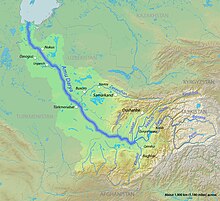Little Amu Darya shovel sturgeon
| Little Amu Darya shovel sturgeon | ||||||||||||
|---|---|---|---|---|---|---|---|---|---|---|---|---|

Small Amu Darya shovel sturgeon ( Pseudoscaphirhynchus hermanni ) |
||||||||||||
| Systematics | ||||||||||||
|
||||||||||||
| Scientific name | ||||||||||||
| Pseudoscaphirhynchus hermanni | ||||||||||||
| ( Kessler , 1877) |
The small Amu Darya shovel sturgeon , also small pseudo -shovel sturgeon , ( Pseudoscaphirhynchus hermanni ) is an endangered or already extinct fish species from the family of sturgeons (Acipenseridae). It is endemic to the Amu Darya in Central Asia.
features
The small Amu Darya shovel sturgeon, like the other shovel sturgeon, has a spindle-shaped body with a broadened front and a broad, flat spatula-shaped snout. Its back is dark brown, its belly white. Morphologically it is very similar to the Great Amu Darya Shovel Sturgeon ( Pseudoscaphirhynchus kaufmanni ), but remains significantly smaller with a body length of 20.7 to 27 centimeters. In addition, the snout is relatively longer and more rounded and has no spines. With age, the length of the snout continues to increase. The eyes are very small. In front of the transverse mouth are two pairs of unfringed barbels , the outer one being twice to three times as long as the inner one. The lower lip is divided in the middle. The five rows of bone scales typical of sturgeon run along the body. These have no or very small spines. The row along the back has 9 to 13 shields, each covering about half of the following shield, with 4 to 5 other small shields behind the 28- to 31-rayed dorsal fin . The side rows count from 30 to 39 like the back row overlapping and the belly rows 6 to 10 shields. The pectoral fins are folded up on their outer edge. The anal fin has 15 to 24 rays, in front of it are 4 to 5, behind it another 1 to 3 small shields. Regularly distributed nodules sit between the bone shields. In contrast to the large Amu Darya shovel sturgeon, the tail fin has no filamentous appendage.
The small Amu Darya shovel sturgeon often formed hybrids with the large Amu Darya shovel sturgeon .
Occurrence and way of life
The species is endemic to the Amu Darya and used to inhabit the lower and middle sections of the river. Almost nothing is known about the way of life. Adult animals mainly feed on insect larvae that live on the ground.
Threat and protection
The small Amu Darya shovel sturgeon is particularly threatened by the destruction of its habitat. The species has always been rare and in 1996 three animals were caught for the first time in 15 years. It is listed in Appendix II of the Washington Convention on Endangered Species and Appendix II of the Bonn Convention and classified in the IUCN Red List as Critically Endangered .
swell
- Vadim J. Birstein: Threatened fishes of the world: Pseudoscaphirhynchus spp. (Acipenseridae) . In: Environmental Biology of Fishes . tape 48 , 1997, pp. 381-383 (English).
- Minister of Supply and Services Canada: CITES Identification Guide - Sturgeons and Paddlefish: Guide to the Identification of Sturgeon and Paddlefish Species Controlled under the Convention on International Trade in Endangered Species of Wild Fauna and Flora . Wildlife Enforcement and Intelligence Division, Environment Canada, 2001, ISBN 0-660-61641-6 (English, French, Spanish, full text [PDF; 10.9 MB ]).
- Pseudoscaphirhynchus hermanni in the endangered Red List species the IUCN 2010. Posted by: Mugue, N., 2010. Accessed October 26, 2012th
- Little Amu Darya Shovel Sturgeon on Fishbase.org (English)
- FAO factsheet
